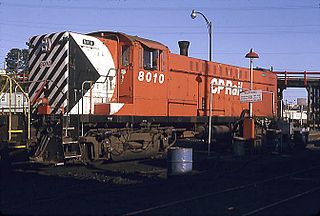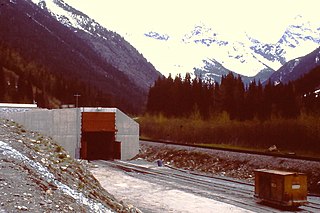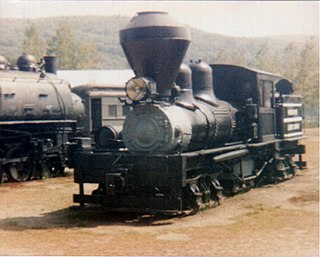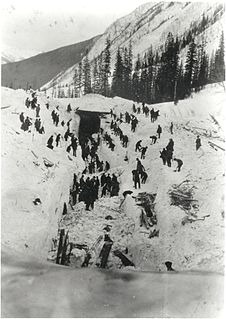Field Hill is a steep portion of the mainline of the Canadian Pacific Railway located near Field, British Columbia. Field was created solely to accommodate the Canadian Pacific Railway's need for additional locomotives to be added to trains about to tackle both Field Hill, and the Big Hill. Here a stone roundhouse with turntable was built at what was first known simply as Third Siding. In December 1884 the CPR renamed it Field after Cyrus W. Field, a Chicago businessman who had visited recently on a special train.

The Canadian Pacific Railway (CPR), also known formerly as CP Rail between 1968 and 1996, and known as simply Canadian Pacific is a historic Canadian Class I railroad incorporated in 1881. The railroad is owned by Canadian Pacific Railway Limited, which began operations as legal owner in a corporate restructuring in 2001.

Field is an unincorporated community of approximately 169 people located in the Kicking Horse River valley of southeastern British Columbia, Canada, within the confines of Yoho National Park. At an elevation of 1,256 m (4,121 ft), it is 27 km (17 mi) west of Lake Louise along the Trans-Canada Highway which provides the only road access to the town.

The Big Hill on the Canadian Pacific Railway main line in British Columbia, Canada, was the most difficult piece of railway track on the Canadian Pacific Railway's route. It was situated in the rugged Canadian Rockies west of the Continental Divide and Kicking Horse Pass. Even though the Big Hill was replaced by the Spiral Tunnels in 1909, the area has long been a challenge to the operation of trains and remains so to this day.
Difficult grades exist in both directions from Field, east through spiral tunnels 137 miles (220 km) to Calgary, Alberta; and 126 miles (203 km) west to Revelstoke, British Columbia, through Rogers Pass and the Connaught Tunnel, and where the modern Mount Macdonald Tunnel was opened in 1989.

A spiral is a technique employed by railways to ascend steep hills.

Revelstoke ( is a city in southeastern British Columbia, Canada with a census population of 6,719 in 2016. By 2019, using smartphone data from Telus Insights, the community reported 14,570 actual residents in December 2018. Revelstoke is located 641 kilometres east of Vancouver, and 415 kilometres west of Calgary, Alberta. The city is situated on the banks of the Columbia River just south of the Revelstoke Dam and near its confluence with the Illecillewaet River. East of Revelstoke are the Selkirk Mountains and Glacier National Park, penetrated by Rogers Pass used by the Trans-Canada Highway and the Canadian Pacific Railway. South of the community down the Columbia River are the Arrow Lakes, Mount Begbie, and the Kootenays. West of the city is Eagle Pass through the Monashee Mountains and the route to Shuswap Lake.

Rogers Pass is a high mountain pass through the Selkirk Mountains of British Columbia used by the Canadian Pacific Railway and the Trans-Canada Highway. The pass is a shortcut across the "Big Bend" of the Columbia River from Revelstoke on the west to Donald, near Golden, on the east. The pass was discovered on May 29, 1881, by Major Albert Bowman Rogers, a surveyor working for the Canadian Pacific Railway. A second pass was named for Rogers in 1887 in Montana, c.373 miles to the south-east.
Following completion of the Spiral Tunnels which eliminated the Big Hill, Field remained an important place as it was still necessary to add helper (bank) engines to get trains over the steep 2.2% (116 feet to the mile, or 22 metres to the kilometre) grade of Field Hill.

A bank engine or helper engine or pusher engine is a railway locomotive that temporarily assists a train that requires additional power or traction to climb a gradient. Helpers/bankers are most commonly found in mountain divisions, where the ruling grade may demand the use of substantially greater motive power than that required for other grades within the division.
Even bigger locomotives were needed and this time six massive 0-6-6-0 Mallet type (see: Whyte notation) were built (one in 1909 and five in 1911). Five were compound engines, the last one a simple engine). These were of a unique design with both pairs of cylinders together at the middle of the boiler. The design was not repeated and eventually these engines were rebuilt (1916–17) into 2-10-0s.

The Whyte notation for classifying steam locomotives by wheel arrangement was devised by Frederick Methvan Whyte, and came into use in the early twentieth century following a December 1900 editorial in American Engineer and Railroad Journal. The notation counts the number of leading wheels, then the number of driving wheels, and finally the number of trailing wheels, numbers being separated by dashes. Other classification schemes, like UIC classification and the French, Turkish and Swiss systems for steam locomotives, count axles rather than wheels.
Under the Whyte notation for the classification of steam locomotives, 2-10-0 represents the wheel arrangement of two leading wheels on one axle, ten powered and coupled driving wheels on five axles, and no trailing wheels. This arrangement was often named Decapod, especially in the United States, although this name was sometimes applied to locomotives of 0-10-0 "Ten-Coupled" arrangement, particularly in the United Kingdom. Notable German locomotives of this type include the war locomotives of Class 52.
More powerful still were the fourteen 2-10-2s built (1919–20) for work on the mountain. These were followed in 1929 by the most powerful steam locomotives in the British Empire, twenty 2-10-4 Selkirks. A further ten were built in 1938 and a final six in 1949, the last one being 5935, the last steam locomotive built for the CPR.
Under the Whyte notation for the classification of steam locomotives, 2-10-2 represents the wheel arrangement of two leading wheels, ten powered and coupled driving wheels, and two trailing wheels. In the United States of America and elsewhere the 2-10-2 is known as the Santa Fe type, after the Atchison, Topeka and Santa Fe Railway that first used the type in 1903.

Under the Whyte notation for the classification of steam locomotives, a 2-10-4 locomotive has two leading wheels on one axle, usually in a bissel truck, ten coupled driving wheels on five axles, and four trailing wheels on two axles, usually in a bogie. These were referred to as the Texas type in most of the United States, the Colorado type on the Burlington Route and the Selkirk type in Canada.

The Selkirk locomotives were 36 steam locomotives of the 2-10-4 wheel arrangement built for Canadian Pacific Railway by Montreal Locomotive Works, Montreal, Quebec, Canada.
Diesel-electric locomotives followed, and over the decades bigger and more powerful diesels replaced smaller ones just as was the case with the steam locomotives that had preceded them.
Even though the Spiral Tunnels eliminated the Big Hill, the mountains remained and so too did the Field Hill. The Ottertail revision of 1902 and the five-mile (26,518 feet or 8.083 kilometres) long double track Connaught Tunnel of 1916 were other improvements made to the original line in British Columbia. It was not until the late 20th century when a major new project of 20 miles (32 km) including the 9.1-mile (14.6 km) Mount Macdonald Tunnel reduced the grade to a very manageable average of 0.82%, (maximum 1%) opened in December 1988.









